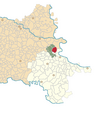Bršadin
Bršadin
| |
|---|---|
 | |
| Coordinates:45°22′N18°55′E/ 45.367°N 18.917°E | |
| Country | |
| Region | Syrmia(Podunavlje) |
| County | |
| Municipality | Trpinja |
| Government | |
| • Body | Local Committee |
| Area | |
| • Total | 14.1 km2(5.4 sq mi) |
| Population (2021)[4] | |
| • Total | 931 |
| • Density | 66/km2(170/sq mi) |
| Demonym(s) | Bršadinac (♂) Bršadinka (♀) (pergrammatical gender) |
| Time zone | UTC+1(CET) |
| • Summer (DST) | UTC+2(CEST) |
| Vehicle registration | VU |
| Official languages | Croatian,Serbian[2] |
Bršadin(Serbian Cyrillic:Бршадин,[5]Hungarian:Borsod) is avillagein theTrpinja MunicipalityinCroatianeasternmostVukovar-Syrmia County.Bršadin is located north of theVukariver and west of the town ofVukovaron the main road toVinkovci.
Geography
[edit]Bršadin is third-largest settlement in the municipality, afterTrpinjaandBobota.It is located on theD55 highwaybetween the towns ofVukovarandVinkovci.Bršadin is surrounded by a villagesBogdanovciandMarincion south,Pačetinon west,Lipovačaon the north and cityVukovaron the east. Agricultural land and forests are the main characteristics of the surrounding area.Bobota Canalis located next to the village.
History
[edit]Before the 20th century
[edit]Bršadin is first mentioned in historical sources in 1279 under the name Boršod. Boršod was located on an elevated area known as the "Old Village", about two kilometers west of the present day settlement.> Boršod decays after 1526Ottoman Empirebreakthrough intoSyrmiaandSlavonia.After 1529,Suleiman the Magnificentcolonized place with firstOrthodoxfamilies,Vlachsfrom northSerbiaand north-easternBosnia,and after 1543 people from the central part of theBalkanspeninsula.
Since 1900
[edit]World War I
[edit]In 1914, at the beginning ofWorld War I,Austro-Hungarian militarycommandmobilization.Bršadin people disliked mobilization asideTriple Ententeand theydesertedin large numbers and taught toRussian armyatEastern Frontor joinSerbianarmy atSalonika front.
During the war, a military hospital with 7000 beds, colloquially known as "Wooden Vienna", was located in the village.
From 27 December 1920 (when they arrived in Vukovar) soldiers and families of theWhite Russian émigréswho were followers ofPyotr Wrangelsettled inBobota,Pačetin,Bršadin, Trpinja andVera.[6]
World War II
[edit]In first days of occupation, Đurđević family were sentenced to death and shot on January 17, 1942 inDudik,location nearVukovarwhere 455 victims were executed.[7]In the spring of 1944,Vaso Đurđević-Turčin,the last of Đurđević brothers, leader of BršadinpartisanandPeople's hero.In his honor, today at the center of village stands remembrance monument.
Croatian War of Independence
[edit]During theCroatian War of IndependenceBršadin was within self-proclaimed Serb political entitySAO Eastern Slavonia, Baranja and Western Syrmia.On December 20, 1993, the village was blocked by protest of the 40th brigade of the 11th corpus of theArmy of the Republic of Serbian Krajina.[8]They requested a pay rise and improved status for soldiers.[8]In the final stages of conflictUnited Nations Missionconducted peaceful reintegrationthis regioninto Croatian jurisdiction.
Languages
[edit]Serbian language
[edit]
Serbian LanguageandSerbian Cyrillic alphabetis the secondofficial languagein most of the villages of the Municipality of Trpinja (except Ćelije) alongside theCroatian languagewhich is official at the national level.[1]Both Serbian and Croatian language are standardized varieties of thepluricentricSerbo-Croatianlanguage. According to the Municipal Statute, individuals who are members of the Serbiannational minorityare ensured thefreedom of expressionof national belonging and freedom to use their language and script in public and private use on the whole territory of the Municipality including the village of Bršadin.[1]The statute guarantees that theSerbian Cyrillic alphabetwill be used in the same font size as the Latin alphabet in the text of the local seals and stamps, on official plates of public representatives, executive and administrative bodies, as well as on those of legal persons with public authorities.[1]
According to the municipal Statute, bilingual signs of the same font are used for written traffic signs and other written traffic markings, street and squares names and names of settlement and geographical localities on the entire territory of the Municipality.[1]Equal public use of Serbian language is required on the basis of theConstitutional Act on the Rights of National Minorities in the Republic of Croatiaand relevant national laws and the country is a party to theEuropean Charter for Regional or Minority Languages.[2]
Education
[edit]Elementary school
[edit]Sport
[edit]There is a local amateur football clubNK Bršadin.
See also
[edit]References
[edit]- ^abcde"Statut Općine Trpinja"(PDF).Retrieved25 May2015.
- ^abcGovernment of Croatia (October 2013)."Peto izvješće Republike Hrvatske o primjeni Europske povelje o regionalnim ili manjinskim jezicima"(PDF)(in Croatian).Council of Europe.p. 36.Retrieved30 November2016.
- ^Register of spatial units of the State Geodetic Administration of the Republic of Croatia.WikidataQ119585703.
- ^"Population by Age and Sex, by Settlements"(xlsx).Census of Population, Households and Dwellings in 2021.Zagreb:Croatian Bureau of Statistics.2022.
- ^"Minority names in Croatia:Registar Geografskih Imena Nacionalnih Manjina Republike Hrvatske"(PDF).Archived fromthe original(PDF)on 2013-10-29.Retrieved2013-03-08.
- ^Barišić Bogišić 2022,pp. 232.
- ^"Generalni Konzulat Republike Srbije".
- ^abNikolić, Kosta (2023).Krajina: 1991.–1995(in Serbo-Croatian).Zaprešić&Zagreb:Fraktura &Serb National Council.p. 204.ISBN978-953-358-654-0.
Sources
[edit]- Barišić Bogišić, Lidija (2022).O neslavenskom stanovništvu na vukovarskom području.Hrvatska sveučilišna naklada.ISBN978-953-169-497-1.











